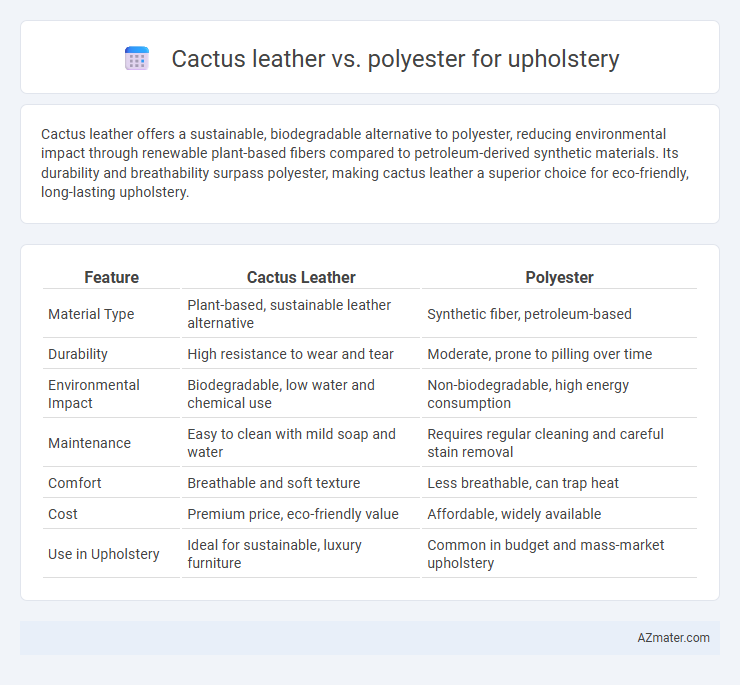Cactus leather offers a sustainable, biodegradable alternative to polyester, reducing environmental impact through renewable plant-based fibers compared to petroleum-derived synthetic materials. Its durability and breathability surpass polyester, making cactus leather a superior choice for eco-friendly, long-lasting upholstery.
Table of Comparison
| Feature | Cactus Leather | Polyester |
|---|---|---|
| Material Type | Plant-based, sustainable leather alternative | Synthetic fiber, petroleum-based |
| Durability | High resistance to wear and tear | Moderate, prone to pilling over time |
| Environmental Impact | Biodegradable, low water and chemical use | Non-biodegradable, high energy consumption |
| Maintenance | Easy to clean with mild soap and water | Requires regular cleaning and careful stain removal |
| Comfort | Breathable and soft texture | Less breathable, can trap heat |
| Cost | Premium price, eco-friendly value | Affordable, widely available |
| Use in Upholstery | Ideal for sustainable, luxury furniture | Common in budget and mass-market upholstery |
Introduction to Cactus Leather and Polyester
Cactus leather, made from the mature leaves of the Nopal cactus, offers a sustainable and biodegradable alternative to traditional upholstery materials with a soft, durable texture. Polyester, a synthetic polymer derived from petroleum, provides high durability, stain resistance, and affordability but lacks biodegradability and contributes to environmental pollution. Choosing between cactus leather and polyester involves weighing eco-friendliness, texture, and longevity for upholstery applications.
Material Origins and Sustainability
Cactus leather, derived from the mature leaves of the Nopal cactus, represents an innovative and biodegradable alternative to traditional upholstery materials with a significantly lower water footprint and no harmful chemicals used in its production. Polyester, a synthetic fabric made from petroleum-based polymers, requires extensive energy consumption and contributes to microplastic pollution, making it less sustainable in comparison. Choosing cactus leather supports eco-friendly practices and reduces reliance on fossil fuels, aligning with sustainable interior design goals.
Environmental Impact Comparison
Cactus leather significantly reduces environmental impact by requiring less water, pesticides, and synthetic chemicals compared to traditional polyester, which is derived from petroleum and contributes to microplastic pollution. The biodegradable nature of cactus leather minimizes landfill waste, whereas polyester persists in the environment for hundreds of years, exacerbating pollution. By choosing cactus leather for upholstery, manufacturers support sustainable practices that lower carbon footprints and reduce dependence on non-renewable fossil fuels.
Durability and Longevity
Cactus leather offers superior durability and longevity compared to polyester upholstery, as it is highly resistant to wear, scratches, and fading while maintaining flexibility over time. Polyester, although affordable and resistant to stains, tends to degrade faster with repeated use and exposure to sunlight, leading to color fading and fabric weakening. The natural resilience and eco-friendly production of cactus leather give it a longer lifespan, making it an excellent choice for sustainable, long-term upholstery solutions.
Comfort and Aesthetics
Cactus leather offers a soft, breathable texture that enhances comfort in upholstery compared to the often less flexible and synthetic feel of polyester. Its natural, matte finish provides an elegant and sophisticated aesthetic, while polyester's glossy appearance can appear less premium and may retain heat. The durability and eco-friendly qualities of cactus leather make it a stylish and sustainable choice for comfortable and visually appealing furniture.
Maintenance and Cleaning Ease
Cactus leather requires minimal maintenance with simple cleaning using a damp cloth and mild soap, making it a sustainable and easy-care option for upholstery. Polyester upholstery is highly durable and stain-resistant, allowing for frequent cleaning with water-based solutions and vacuuming, but may retain odors over time. Both materials offer practical benefits, with cactus leather excelling in eco-friendly upkeep and polyester providing robust resistance to wear and dirt.
Cost and Accessibility
Cactus leather offers an eco-friendly alternative with moderate cost and increasing availability, appealing to sustainable upholstery markets. Polyester remains widely accessible and cost-effective, benefiting from mass production and established supply chains. Choosing between cactus leather and polyester for upholstery often depends on balancing budget constraints with environmental considerations.
Consumer Health and Safety
Cactus leather is a sustainable, non-toxic alternative to polyester that avoids harmful chemicals often used in synthetic production, reducing indoor air pollution and potential respiratory issues for consumers. Polyester upholstery may release volatile organic compounds (VOCs) and microplastics over time, which can pose health risks such as allergies or skin irritations. Choosing cactus leather supports hypoallergenic environments and minimizes exposure to synthetic toxins, promoting better long-term health and safety in living spaces.
Popular Uses in Upholstery
Cactus leather and polyester are both popular choices for upholstery with distinct applications; cactus leather is favored for eco-friendly, high-end furniture due to its durability, natural texture, and sustainable production process. Polyester is widely used in commercial and residential upholstery for its affordability, stain resistance, and easy maintenance. Cactus leather suits modern, eco-conscious designs while polyester remains preferred for budget-friendly, versatile furniture covering.
Final Verdict: Which Is Better for Upholstery?
Cactus leather offers superior sustainability and breathability compared to polyester, making it an eco-friendly choice for upholstery with a natural look and feel. Polyester, while affordable and highly durable, lacks the environmental benefits and breathability of cactus leather but excels in stain resistance and ease of maintenance. For upholstery prioritizing eco-conscious materials and natural aesthetics, cactus leather is better, whereas polyester suits budget-friendly, high-traffic applications.

Infographic: Cactus leather vs Polyester for Upholstery
 azmater.com
azmater.com